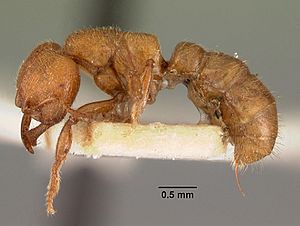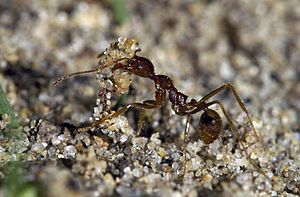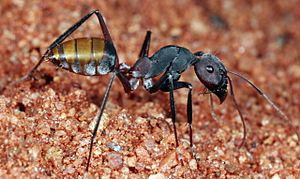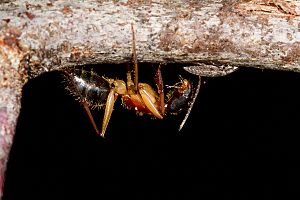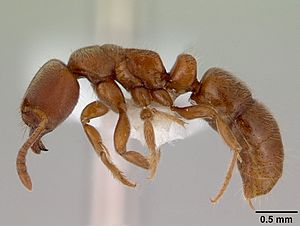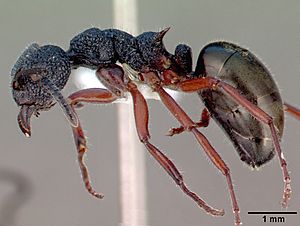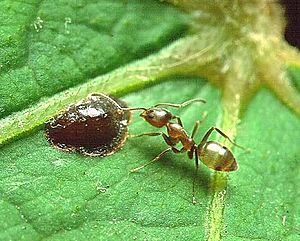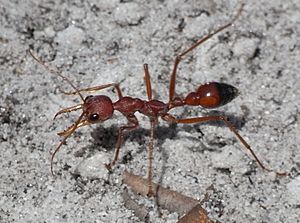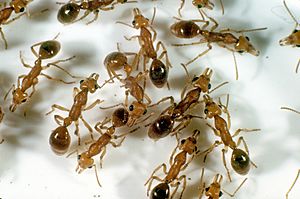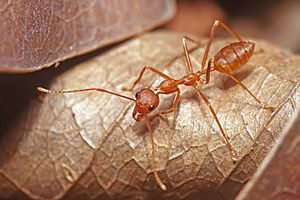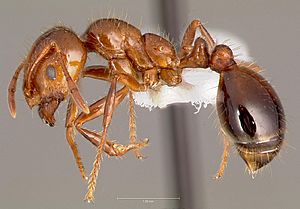List of ants of Australia facts for kids
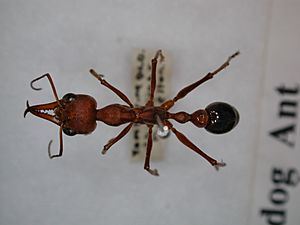
Australia is home to a huge and varied collection of ants! In 1999, scientists had described 1,275 different types of ants (including subspecies) in Australia and its nearby islands. These ants belonged to 103 groups called genera and 10 larger groups called subfamilies. Since then, even more ants have been discovered, and now Australia has about 12 ant subfamilies. Very few of the ant species in Australia are considered invasive, meaning they don't cause problems for the local environment.
Australia is special because it has two-thirds of all the ant subfamilies found worldwide. It also has one-third of all known ant genera and about 15% of all described ant species. Some ant groups found in Australia can't be found anywhere else! While places like Central America, South America, and Southeast Asia have more ant diversity, Australia has about the same number of genera and species as the Orient (Asia) and more than Europe, North America, Northern Asia, and Northern Africa. The state of Queensland, in particular, is an ant hotspot, with over 1,400 species known there – that's more than anywhere else in the world! Scientists believe there could be over 6,500 ant species in Australia, but only about one in five have been officially described.
Contents
- Ant Subfamilies in Australia
- Meet Some Australian Ant Genera
- Acropyga
- Adlerzia
- Aenictus
- Amblyopone
- Anochetus
- Anonychomyrma
- Anoplolepis
- Aphaenogaster
- Arnoldius
- Austromorium
- Austroponera
- Brachyponera
- Calomyrmex
- Calyptomyrmex
- Camponotus
- Cardiocondyla
- Carebara
- Colobopsis
- Colobostruma
- Crematogaster
- Cryptopone
- Diacamma
- Dilobocondyla
- Discothyrea
- Doleromyrma
- Dolichoderus
- Echinopla
- Ectomomyrmex
- Epopostruma
- Eurhopalothrix
- Froggattella
- Gnamptogenys
- Heteroponera
- Hypoponera
- Iridomyrmex
- Iroponera
- Leptanilla
- Leptogenys
- Leptomyrmex
- Linepithema
- Lioponera
- Lordomyrma
- Mayriella
- Melophorus
- Meranoplus
- Mesoponera
- Mesostruma
- Metapone
- Monomorium
- Myopias
- Myopopone
- Myrmecia
- Myrmecina
- Myrmecorhynchus
- Mystrium
- Nebothriomyrmex
- Nothomyrmecia
- Notoncus
- Notostigma
- Nylanderia
- Ochetellus
- Odontomachus
- Oecophylla
- Onychomyrmex
- Ooceraea
- Opisthopsis
- Orectognathus
- Papyrius
- Paraparatrechina
- Paratrechina
- Parvaponera
- Peronomyrmex
- Pheidole
- Philidris
- Plagiolepis
- Platythyrea
- Podomyrma
- Polyrhachis
- Ponera
- Prionopelta
- Pristomyrmex
- Probolomyrmex
- Proceratium
- Prolasius
- Pseudolasius
- Pseudoneoponera
- Pseudonotoncus
- Pseudoponera
- Rhopalomastix
- Rhopalothrix
- Rhytidoponera
- Romblonella
- Solenopsis
- Stereomyrmex
- Stigmacros
- Stigmatomma
- Strumigenys
- Syllophopsis
- Tapinoma
- Technomyrmex
- Teratomyrmex
- Tetramorium
- Tetraponera
- Trichomyrmex
- Turneria
- Vollenhovia
- Vombisidris
- Wasmannia
- Zasphinctus
- See also
Ant Subfamilies in Australia
In 1999, scientists knew about 10 ant subfamilies living in Australia. However, some of these groups were later combined under a subfamily called Dorylinae. Today, Australia is home to 12 known ant subfamilies. These include Amblyoponinae, Dolichoderinae, Dorylinae, Ectatomminae, Formicinae, Heteroponerinae, Leptanillinae, Myrmeciinae, Myrmicinae, Ponerinae, Proceratiinae and Pseudomyrmecinae.
The Myrmicinae subfamily is the biggest ant group in Australia, both in the number of different genera and species it contains. The Formicinae subfamily is also very common. The Myrmeciinae subfamily includes two genera that are found only in Australia, except for one species that lives in New Caledonia. Interestingly, only one species from the Leptanillinae subfamily is known to live in Australia.
Meet Some Australian Ant Genera
Australia is home to many fascinating ant genera. Here are some of them:
Acropyga
These ants are known for their small size and for "farming" tiny insects called mealybugs underground. They protect the mealybugs, and in return, the mealybugs provide a sweet liquid called honeydew for the ants to eat.
Adlerzia
The only known species in this genus is Adlerzia froggatti, sometimes called the Thumbelina ant because of its small size.
Aenictus
These ants are often called army ants. They are known for their large groups that move together, hunting for food.
Amblyopone
These ants are also known as Dracula ants or Michelin ants. They are predators, meaning they hunt other small insects and arthropods for food.
Anochetus
These ants are sometimes called trap-jaw ants because of their powerful, fast-snapping jaws. They use these jaws to catch prey or even to jump away from danger.
Anonychomyrma
This group includes ants like the Forest black cocktail ant and the Golden-black cocktail ant. They are known for their unique body shapes.
Anoplolepis
One notable species here is Anoplolepis gracilipes, also known as the Crazy ant. This is an introduced species in Australia, meaning it came from another country and can sometimes cause problems for local wildlife.
Aphaenogaster
These ants are often called funnel ants because of the funnel-shaped entrances to their nests. They include species like the Desert funnel ant and the Forest funnel ant.
Arnoldius
This genus contains several species, including Arnoldius flavus and Arnoldius pusillus.
Austromorium
Two species are known in this genus: Austromorium flavigaster and Austromorium hetericki.
Austroponera
The only known species in this genus is Austroponera rufonigra.
Brachyponera
This genus includes Brachyponera croceicornis and Brachyponera lutea.
Calomyrmex
These ants are often called beauty ants because of their shiny, colorful bodies. Examples include the Black beauty ant and the Speckled beauty ant.
Calyptomyrmex
This genus has several species, many of which were described recently in 2011.
Camponotus
This is a very large group of ants, often called sugar ants or carpenter ants. They are known for their love of sweet foods and for sometimes nesting in wood. Some famous species are the Black-headed sugar ant and the Australian honey-pot ant, which store liquid food in their bodies.
Cardiocondyla
These are small ants, often found in warm climates.
Carebara
This genus includes some very tiny ants, as well as species with different sizes of workers in the same colony.
Colobopsis
This genus includes the Southern rectangle plug ant and the interesting Colobopsis explodens, which can explode as a defense mechanism!
Colobostruma
This group of ants has a unique body shape, often with spines or bumps.
Crematogaster
These ants are known as valentine ants or cocktail ants because of their heart-shaped abdomens (the rear part of their body) that they can raise when disturbed.
Cryptopone
Cryptopone rotundiceps is one of the species in this genus.
Diacamma
These ants are sometimes called bladder ants. Diacamma australe is known as the Australian bladder ant.
Dilobocondyla
Dilobocondyla cataulacoidea is a species in this genus.
Discothyrea
These are small, often hidden ants.
Doleromyrma
This genus includes the Brown house ant, a common ant found in homes.
Dolichoderus
These ants are often called dolly ants or sharkfined dolly ants, known for their strong smell when crushed.
Echinopla
Echinopla australis and Echinopla turneri are species in this genus.
Ectomomyrmex
This genus includes Ectomomyrmex astutus and Ectomomyrmex ruficornis.
Epopostruma
These ants are known for their unique trap-jaw mandibles, which they use to catch prey.
Eurhopalothrix
This genus includes Eurhopalothrix australis.
Froggattella
Froggattella kirbii is known as the Common froglet ant.
Gnamptogenys
Gnamptogenys biroi is a species in this genus.
Heteroponera
This genus includes several species, many of which were described recently in 2011 and 2015.
Hypoponera
These are small, often pale ants that live in the soil or under logs.
Iridomyrmex
This is a very common and diverse group, including the famous Meat ant (Iridomyrmex purpureus). They are known for their large, active colonies and sometimes for their metallic sheen.
Iroponera
Iroponera odax is a species in this genus.
Leptanilla
Only one species, Leptanilla swani, is known from Australia in this genus of tiny, often blind, ants.
Leptogenys
These ants are often called killer ants or genial killer ants, known for hunting in groups.
Leptomyrmex
These are often called spider ants because of their long legs and slender bodies. The Red-headed spider ant (Leptomyrmex erythrocephalus) is a well-known example.
Linepithema
Linepithema humile, the Argentine ant, is an introduced species that can be very invasive.
Lioponera
These ants are sometimes called cannibal ants, like the Little cannibal ant or the Carinate cannibal ant.
Lordomyrma
This genus includes Lordomyrma leae and Lordomyrma punctiventris.
Mayriella
These are small ants, often found in dry areas.
Melophorus
These ants are often called furnace ants or harvester furnace ants. They are well adapted to hot, dry environments.
Meranoplus
These ants are known as shield ants or turtle ants because of their tough, armored bodies.
Mesoponera
This genus includes Mesoponera australis and Mesoponera rubra.
Mesostruma
These ants also have unique trap-jaw mandibles.
Metapone
This genus includes several species, some of which were described recently in 2016.
Monomorium
This is a very large and diverse genus, including common household pests like the Pharaoh ant (Monomorium pharaonis) and the Little black mono ant.
Myopias
This genus includes Myopias chapmani and Myopias tasmaniensis.
Myopopone
Myopopone castanea is a species in this genus.
Myrmecia
These are the famous bulldog ants or bull ants, known for their large size, powerful stings, and excellent eyesight. The Giant red bull ant (Myrmecia gulosa) and the Jack jumper ant (Myrmecia pilosula) are well-known examples.
Myrmecina
This genus includes several species, many described in 2009.
Myrmecorhynchus
This genus includes Myrmecorhynchus carteri and Myrmecorhynchus emeryi.
Mystrium
Mystrium camillae is a species in this genus.
Nebothriomyrmex
Nebothriomyrmex majeri is a species in this genus.
Nothomyrmecia
This genus contains only one species, Nothomyrmecia macrops, famously known as the Dinosaur ant. It's considered a "living fossil" because it has features similar to very ancient ants.
Notoncus
These ants are sometimes called epaulet ants.
Notostigma
This genus includes Notostigma carazzii and Notostigma foreli.
Nylanderia
These ants are sometimes called parrot ants, like the Swamp parrot ant or the Forest parrot ant.
Ochetellus
This genus includes the Black house ant (Ochetellus glaber), a common ant found around homes.
Odontomachus
These are also known as snappy ants or trap-jaw ants, famous for their incredibly fast jaw movements.
Oecophylla
Oecophylla smaragdina is the Green tree ant, known for building nests by weaving leaves together using silk produced by their larvae.
Onychomyrmex
This genus includes Onychomyrmex doddi and Onychomyrmex hedleyi.
Ooceraea
Ooceraea australis is known as the Blind cannibal ant.
Opisthopsis
These ants are called strobe ants because of their large eyes and quick, jerky movements.
Orectognathus
These ants are also known for their unique trap-jaw mandibles.
Papyrius
This genus includes the Red cocktail ant (Papyrius nitidus).
Paraparatrechina
This genus includes Paraparatrechina minutula and Paraparatrechina nana.
Paratrechina
Paratrechina longicornis, the Hairy ant, is an introduced species in Australia.
Parvaponera
Parvaponera darwinii is a species in this genus.
Peronomyrmex
This genus includes Peronomyrmex bartoni and Peronomyrmex greavesi.
Pheidole
This is a very large group of ants, often called big-headed ants because some workers have very large heads. They include species like the Coastal brown ant (Pheidole megacephala) and harvester bigheaded ants.
Philidris
Philidris cordata is a species in this genus.
Plagiolepis
This genus includes several species, many described in 1934.
Platythyrea
These ants are sometimes called broadnosed killer ants.
Podomyrma
These ants are sometimes called muscleman ants.
Polyrhachis
These ants are known as spiny ants because many species have spines on their bodies. They are also called weaver ants, similar to Oecophylla, as some species also weave nests from leaves.
Ponera
These ants are sometimes called crypt ants or blind crypt ants.
Prionopelta
Prionopelta robynmae is a species in this genus.
Pristomyrmex
This genus includes several species, many described in the 1960s.
Probolomyrmex
This genus includes Probolomyrmex greavesi.
Proceratium
This genus includes several species, many described in 2003.
Prolasius
These ants are sometimes called mistral ants.
Pseudolasius
Pseudolasius australis is a species in this genus.
Pseudoneoponera
These ants are sometimes called foaming ants, like the Eared foaming ant or the Striped foaming ant.
Pseudonotoncus
This genus includes Pseudonotoncus eurysikos and Pseudonotoncus hirsutus.
Pseudoponera
This genus includes Pseudoponera pachynoda and Pseudoponera stigma.
Rhopalomastix
Rhopalomastix rothneyi is a species in this genus.
Rhopalothrix
Rhopalothrix orbis is a species in this genus.
Rhytidoponera
These ants are commonly known as pony ants or green-head ants (like Rhytidoponera metallica). They are known for their metallic colors and often for their painful stings.
Romblonella
Romblonella heatwolei is a species in this genus.
Solenopsis
This genus includes the well-known fire ants, such as the Tropical fire ant (Solenopsis geminata) and the highly invasive Red imported fire ant (Solenopsis invicta). They are known for their painful stings.
Stereomyrmex
Stereomyrmex anderseni is a species in this genus.
Stigmacros
This genus includes many species, many described in 1957.
Stigmatomma
This genus includes several species, many described in the 1920s and 1930s.
Strumigenys
These are tiny, often hidden ants with unique trap-jaw mandibles.
Syllophopsis
This genus includes Syllophopsis australica.
Tapinoma
This genus includes the Ghost ant (Tapinoma melanocephalum), a very small ant often found in houses.
Technomyrmex
This genus includes the White-footed ant (Technomyrmex albipes), another common household ant.
Teratomyrmex
This genus includes Teratomyrmex greavesi.
Tetramorium
These ants are sometimes called pennant ants, like the Guinea ant or the Royal pennant ant.
Tetraponera
These ants are often called tree-ants, like the Toothed black tree-ant or the Savanna black tree ant.
Trichomyrmex
Trichomyrmex destructor, the Singapore ant, is an introduced species in Australia.
Turneria
This genus includes Turneria bidentata and Turneria frenchi.
Vollenhovia
Vollenhovia oblonga is a species in this genus.
Vombisidris
This genus includes Vombisidris australis.
Wasmannia
Wasmannia auropunctata is another introduced species in Australia, sometimes called the little fire ant.
Zasphinctus
This genus includes many species, many described in the early 1900s.
|
See also
- List of ant genera
- List of ant subfamilies



